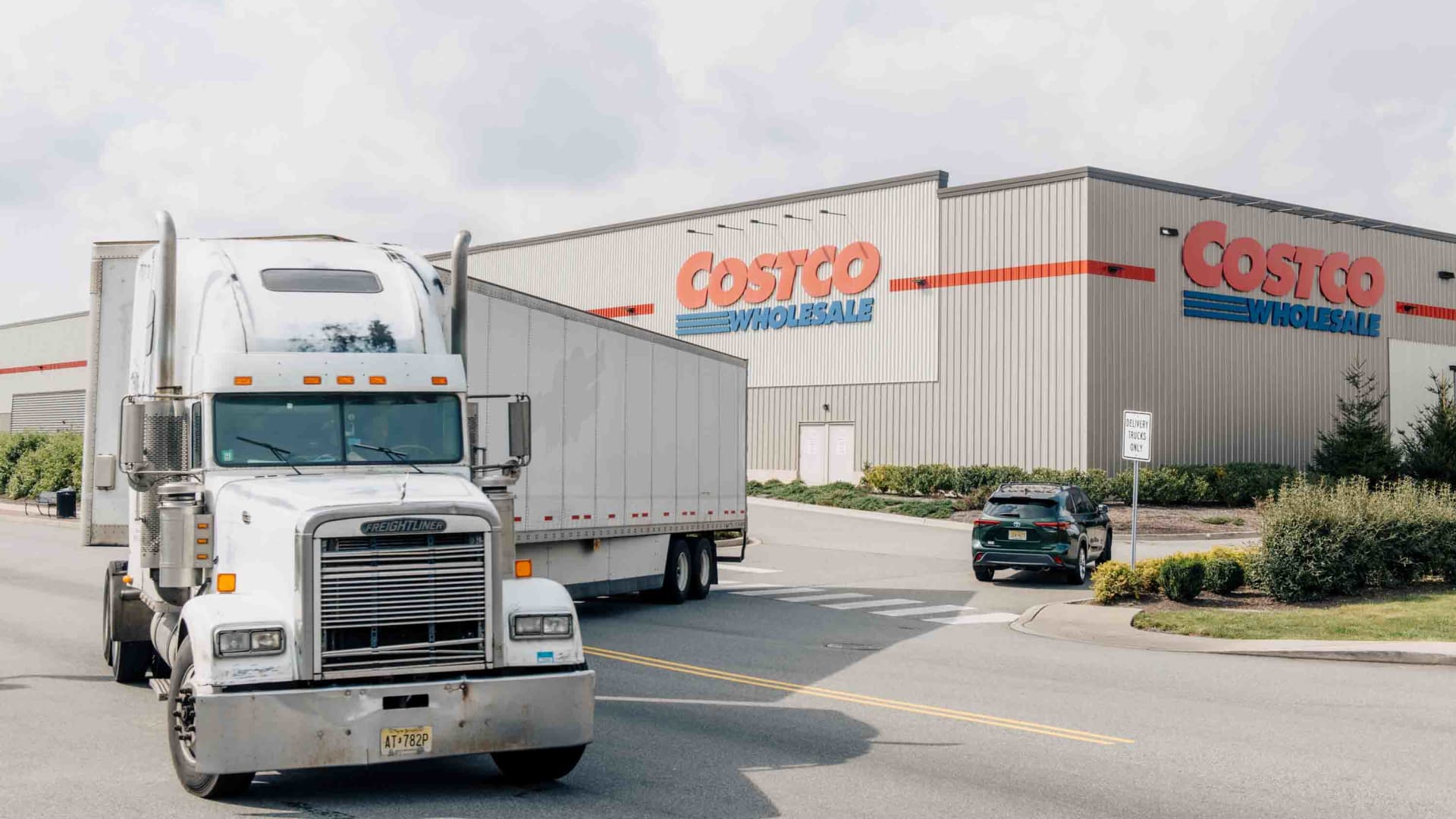
Costco built its brand on supermarket staples. If you wanted a truckload of toilet paper or enough ham to pack 50 sandwiches, it was the place to go. But Costco has increasingly moved beyond mustard and milk.
The most well-known “surprise” in Costco’s sales success strategy may be the boom in gold bars bought by its customers in recent years. But the big-box retailer is also seeing a boom in sales of saunas and sofas, many of them purchased online. In industry parlance, these purchases are termed “big and bulky.”
On a recent afternoon at the Costco Warehouse in Liberty Township, Ohio, a constant stream of customers sat on, ran their hands over, and leaned on a prominent display of Thomasville sofas. Some customers stared in awe at the sofas as if they had never seen one before. Maybe they just weren’t expecting to see one at Costco. While it is still new to some customers, the retail chain’s move into items like furniture has been picking up steam, and market share, over the past few years.
Here is what the company’s top executives and retail experts say about the continued shift in branding, and the various ways it can help the retailer continue to grow its membership business and diversify sales.
It’s a good way to drive business online and into a company app.
A worker at the Liberty Township Costco Warehouse explained that if you buy the sofas at the physical store, you have to bring your own truck and you have to cart it away on the spot. If you order online, though, he noted, Costco’s delivery network will bring the new sofa to you and get rid of the old.
While there are some shoppers that haul sofas out of Costco, the majority of the big and bulky business is online, which has plenty of more room to grow.
E-commerce sales neared $20 billion in the company’s most recent fiscal year, increasing over 15%, according results shared by Costco on Thursday with its fiscal fourth quarter earnings. Online sales now total more than 7% of Costco’s annual net sales. Costco chief financial officer Gary Millerchip has noted in the past that only around half of members have downloaded the Costco app, suggesting that the addressable market is much larger.
About a year ago, Ron Vachris, the company’s CEO, said on the Costco Q3 2024 earnings call that sales of $1,200 swing sets were “blowing out” expectations. He said at that time 80%-85% of big and bulky items were being delivered through its logistics arm.
That momentum has continued, based on the fourth quarter results, with Millerchip telling analysts on a Thursday earnings call that the company continues “to grow share in big and bulky items sold online,” with the Costco Logistics playing a big role and resulting in a 13% increase in items delivered in the quarter. Last quarter, Costco had cited a 31% increase in deliveries via Costco Logistics, reflective of the trend towards bigger-ticket items.
The increased appearance of large items in Costco’s retail stores also reflects an opportunity to showcase the limited-run products that they have been selling online, according to Melissa Akaka, associate dean for research and brand strategy at the Daniels College of Business at the University of Denver. That translates into an opportunity for Costco to expand its share of the market, and membership rolls, by targeting a customer segment who might not have thought of the wholesaler as a place to buy home furnishings or high-end products before.
She is a case in point: Akaka’s family recently ordered new countertops, a refrigerator, and a dishwasher from Costco.
Millerchip told CNBC over the summer that the average age of the company’s members has fallen, and just under half of its new signups each year are from people under 40.
A brand’s continued success always requires evolution.
Elizabeth Lafontaine, director of research at Placer.ai, says that the company is riding a wave of goodwill towards the brand.
“Costco’s expansion of product categories seems to be in direct response to how its shoppers view the retail chain: as a trusted brand that offers great inherent value on exclusive products,” Lafontaine says. She notes that Costco’s high percentage of visitor loyalty and adaptable merchandising model allow the retailer to push the limits of what consumers think of as traditional warehouse club items and services. “That in turn helps to shift the consumer perception around the chain as a whole,” Lafontaine said.
The growth in visits to the retailer in 2025, as well as other warehouse club brands, may create more competition with other discretionary retailers who sell large-ticket items, as Costco becomes a more top-of-mind choice for shoppers. “As the chain looks to grow and evolve, they will likely continue to push the limits of what products it can offer its members,” Lafontaine said.
It drives higher-margin sales in what’s been a lower-margin business.
Industry experts say a pivot towards big and bulky is part of a calculated Costco campaign to shield itself from volatility in lower margin categories due to tariffs and other macroeconomic uncertainty. “Recent shifts in policy and the overall economy have consumers paying more attention to the cost of goods, including large and luxury items,” said Akaka.
Michael Zakkour, founder and chief strategist at brand consultancy 5 New Digital, said Costco’s pivot allows it to cater to a more affluent customer base that doesn’t necessarily need to save money, but still likes a deal. “These are the same consumers who celebrated shopping at Target over the last decade. They don’t necessarily need to spend less at mass-market retailers, but they like to,” Zakkour said. “While there is an effort to attract a set of wealthier, net new customers, this may be more about servicing and keeping aspirational, monied consumers who are in for a $20 pair of jeans and a 50-pack of paper towels,” he added.
“Costco’s focus on bigger, higher-margin items is a smart way to encourage trade-up behavior and drive higher receipts per trip,” said Shikha Jain, lead partner for consumer and retail in North America and head of the Boston office at consultancy Simon-Kucher.
Start with a few items and then extend.
In the Costco of yesteryear, a month’s supply of toilet paper might have been the largest item available, but as the company’s has built out its delivery capability, larger is everywhere to be found among their inventory. Some of the more noteworthy items:
Whisper W5XL – 6 seat off-road recreational golf cart
Dynamic Toledo 6-person Hybrid Full Spectrum Sauna
Mini-Digital Grand Piano
Samsung 29 cu. ft. Bespoke 4-Door French Door Refrigerator with Family Hub
California King bed with storage
Costco’s collection has sparked an arms race among the biggest retailers for the big and bulky business, with Amazon and Walmart in the game (not to be outdone, you can buy a Revolution Outdoors E4X 6-Seater 60V Lithium Ion Golf Cart for Outdoors at Walmart for $12,000).
The success is changing Costco’s approach to holiday sales this year.
Vachris said on the Thursday earnings call that this upcoming holiday season will mark another new push with the big and bulky item boom, with the CEO telling analysts that the retailer is stocking categories that it has not carried in the past during the season.
“We’re bringing in backyard sheds in the fall, which are doing very, very well for us, but we never have the ability to do that due to space constraints. We’re bringing in saunas for your garage or your home which are also performing very well, high-ticket goods that are very relevant to the time of year, but not reflective of the traditional Costco set. You’ll see some more furniture in the warehouses … we normally didn’t do any furniture at that time of the year.”
Big business brand pivots do come with risks.
Any big change in brand presents potential risks for an already successful business model, according to Jain, some that relate to consumer psychology and which while they may be hard-to quantify do need to be weighed. For example, shoppers not accustomed to seeing oversized items in a physical store could begin to shift the way they think about what Costco has always offered for their car trunk and pantry-sized consumer life. That makes the trend toward larger items a balancing act for Costco, with the company needing to align the psychology of getting a good deal with growing the customer’s lifetime value, she said.
“There are potential hazards in this recent pivot. There is a risk of alienating working and middle-class shoppers on price points and the beloved Costco experience,” Zakkour said.
But he does not think Costco is likely to stumble in the short-term.
“For now, gold bars, diamonds, and expensive patio sets are becoming as core to Costco as five gallons of Hellmann’s, vacation packages, and cheap gas. I’ve never bet against Costco, and I am not about to start now,” he said.



